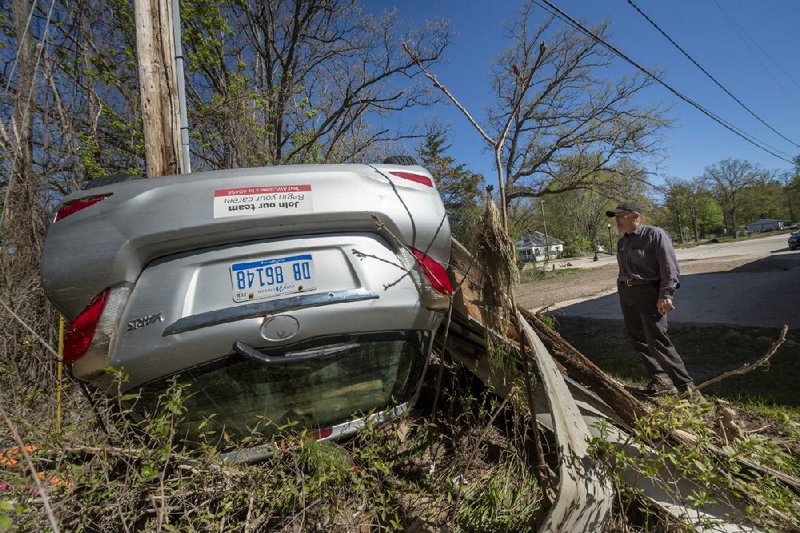TRAVERSE CITY, Mich. -- A hydroelectric dam that failed to hold back floodwaters this week in Michigan was the target of lengthy investigations by federal regulators, who revoked the facility's license over safety violations two years before the flooding that has forced thousands to evacuate their homes.
Many central Michigan residents remained cut off from their homes Thursday even as floodwaters receded, with senior citizens among the scores of displaced people staying in shelters after flooding overwhelmed two dams, submerged homes and washed out roads.
President Donald Trump, who was in Michigan to visit a Ford production plant, signed an emergency declaration authorizing the Department of Homeland Security and the Federal Emergency Management Agency to coordinate disaster-relief efforts.
Boyce Hydro Power's history of violations lasted throughout the 14 years the company was authorized to run the nearly century-old Edenville dam, according to the Federal Energy Regulatory Commission, which said it repeatedly raised concerns about the dam's ability to prevent flooding during extreme conditions because of its inadequate spillway capacity.
[Video not showing up above? Click here to watch » https://www.youtube.com/watch?v=1csm7ArDP-Y]
Gov. Gretchen Whitmer said the state will investigate the dam operators.
The commission ordered Boyce Hydro to form an independent team to investigate three other dams it owns on the rivers that were vulnerable to a "cascading failure scenario." Among them was the Sanford Dam, which also was damaged.
The commission planned to send a staff engineer to the site to assist with the investigation as soon as it could be done safely, Chairman Neil Chatterjee said in a statement.
The governor said the state was "reviewing every possible legal recourse."
Lee Mueller, architect and co-member manager of the company, did not return calls for comment Wednesday from The Associated Press.
The Edenville dam, in Michigan's Gladwin and Midland counties, includes a series of earthen embankments about 6,600 feet long, with a maximum height of nearly 55 feet. It forms a 2,600-acre reservoir known as Wixom Lake, a popular boating and fishing spot.
The dam has two reinforced concrete spillways to carry away excess water when reservoir levels get too high.
In its 2018 order revoking Boyce Hydro's license, the commission said its primary concern about the dam was its inability to handle "the probable maximum flood" -- the type of event that could be expected from "the most severe combination of critical meteorologic and hydrologic conditions that is reasonably possible" in the area.
Commission guidelines require that dams be able to withstand such a flood or have enough spillway capacity to prevent reservoirs from rising dangerously high. The Edenville dam's spillway capacity was only about 50% of the probable maximum flood, the commission said.
Much of the area remained under water, including in Midland, the headquarters of Dow Chemical Co. And floodwaters continued to threaten downstream communities.
It could be days before the full scope of damage can be assessed, officials said. No flood-related deaths or injuries have been reported.
"The damage is truly devastating to see how high the water levels are, to see roofs barely visible in parts of Midland, and to see a lake that has been drained in another part," said Whitmer, who toured Midland County on Wednesday.
The flooding forced about 11,000 people to evacuate their homes in the Midland area, about 140 miles north of Detroit, after what the National Weather Service called "catastrophic dam failures."
Midland City Manager Brad Kaye said it was fortunate that the Tittabawassee River crested at just over 35 feet, about 3 feet below the forecast level.
Kaye warned that it could take four or five days for the floodwaters to recede, and asked residents to use caution when traveling or returning to their homes.
"Don't rush out thinking that you can just rush back to your homes, because the water is still there ... this is not over," Kaye said.
The National Weather Service said communities farther downstream should expect flooding in the coming days.
The flooding washed away some roadways, and left others impassable. Tisdale said roads must be inspected for damage that could make traveling hazardous.
Information for this article was contributed by Mike Casey, Mike Householder, Corey Williams and Tammy Webber of The Associated Press.
A Section on 05/22/2020
